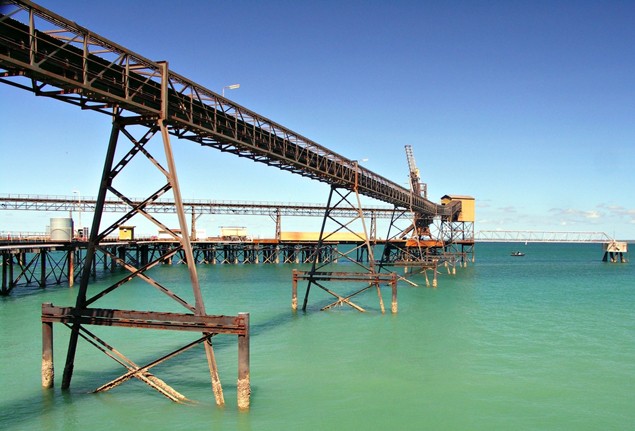Firms in Fed’s Beige Book Fret Over Any Lengthy Baltimore Port Closure
(Bloomberg) — The closure of one of the East Coast’s busiest ports after the collapse of Baltimore’s Francis Scott Key Bridge has so far not led to broad price increases,...




(Bloomberg) — Iron ore is poised to decline through the end of March as China, the world’s largest user, has a week-long holiday next month and mills buy more domestic supplies, Australia & New Zealand Banking Group Ltd. said.
The price may drop to $140 a metric ton by the end of the first quarter, Mark Pervan, global head of commodity strategy, said in a report today. Iron ore with 62 percent content delivered to the Chinese port of Tianjin was at $148.40 a dry ton yesterday, according to data from The Steel Index Ltd.
Iron ore rallied from near a three-year low in September as China’s growth accelerated in the final quarter and ore imports rose to a record on mills’ restocking. A slump in Capesize ship rates in December flagged a drop in imports into China this month, Pervan wrote. Financial markets in the second-largest economy will close for a week starting Feb. 11 to mark the Lunar New Year.
“Trading is already starting to wind down for the Chinese Lunar New Year,” Pervan wrote. “We also hear that steel mills are buying a higher level of cheaper domestic iron ore” as they seek to reduce costs, he said.
February ore swaps gained $1 to $148 a ton as of 9:09 a.m. in London, according to figures from GFI Group Inc.
Down to $110?
The steelmaking raw material reached $158.50 a ton on Jan. 8, the highest level since October 2011, after rallying from $86.70 in September. The advance is unsustainable, according to a Jan. 21 report from Bank of America Corp., which forecast a drop to $110 by year-end as global supply increases.
Daily average charter costs for Capesizes, the largest ore carriers, declined 2.1 percent to $7,623 yesterday, according to the Baltic Exchange, the London-based publisher of freight rates. The Baltic Capesize Index dropped 44 percent in December.
Vale SA, the biggest iron-ore producer, said yesterday prices will be supported this year by Chinese growth. The Rio de Janeiro-based company is optimistic as China is set to increase spending on infrastructure and construction, Investor Relations Director Roberto Castello Branco said.
“We remain upbeat on the outlook for iron ore from the second quarter as further government stimulus and improving economic data confirms a better China growth outcome,” Pervan said. The commodity may trade from $130 to $150 a ton this year, he said.
China’s economic growth sped up to 7.9 percent in the fourth quarter, ending a seven-quarter slowdown. Growth may gain to 8.1 percent this quarter, the median estimate compiled by Bloomberg shows. Chinese manufacturing is expanding at the fastest rate in two years this month, a preliminary survey from HSBC Holdings Plc and Markit Economics showed Jan. 24.
Iron ore is measured in dry tons, or metric tons less moisture. At Tianjin, moisture can account for 8 percent to 10 percent of weight. Chinese ore imports rose to a record 70.9 million tons last month, customs data showed.
– Phoebe Sedgman, Copyright 2013 Bloomberg.
Join the gCaptain Club for curated content, insider opinions, and vibrant community discussions.


Join the 105,960 members that receive our newsletter.
Have a news tip? Let us know.
Access exclusive insights, engage in vibrant discussions, and gain perspectives from our CEO.
Sign Up




Maritime and offshore news trusted by our 105,960 members delivered daily straight to your inbox.



Essential news coupled with the finest maritime content sourced from across the globe.
Sign Up